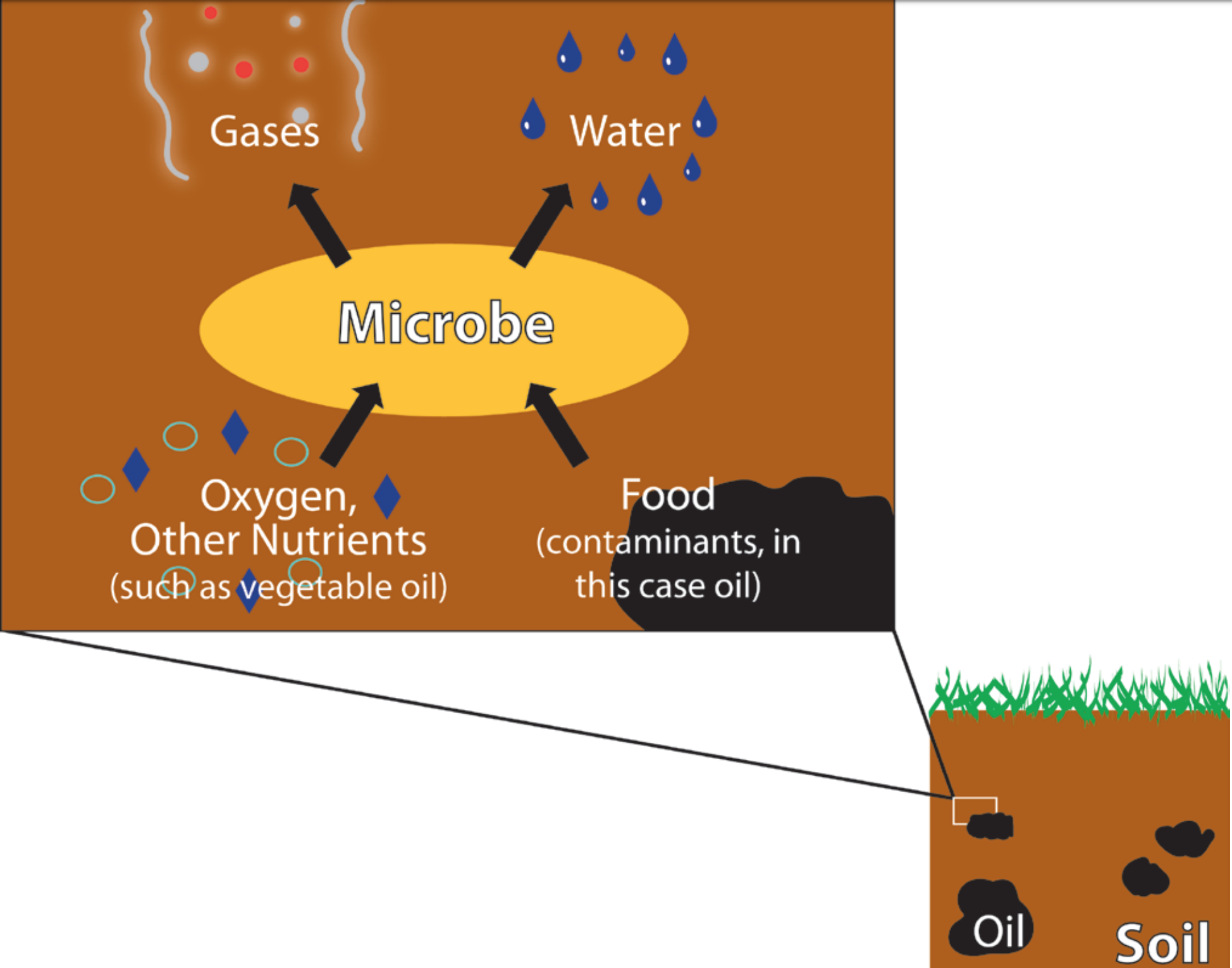What Is Bioremediation?
Bioremediation is the use of microbes to clean up contaminated soil and groundwater. Microbes are very small organisms, such as bacteria, that live naturally in the environment. Bioremediation stimulates the growth of certain microbes that use contaminants as a source of food and energy. Contaminants treated using bioremediation include oil and other petroleum products, solvents, and pesticides.
How Does It Work?
Some types of microbes eat and digest contaminants, usually changing them into small amounts of water and harmless gases like carbon dioxide and ethene. If soil and groundwater do not have enough of the right microbes, they can be added in a process called “bioaugmentation.” For bioremediation to be effective, the right temperature, nutrients, and food also must be present. Proper conditions allow the right microbes to grow and multiply—and eat more contaminants. If conditions are not right, microbes grow too slowly or die, and contaminants are not cleaned up. Conditions may be improved by adding “amendments.” Amendments range from household items like molasses and vegetable oil, to air and chemicals that produce oxygen. Amendments are often pumped underground through wells to treat soil and groundwater in situ (in place).
Bioremediation diagram
Why Use Bioremediation?
Bioremediation has the advantage of using natural processes to clean up sites. Because it may not require as much equipment, labor, or energy as some cleanup methods, it can be cheaper. Another advantage is that contaminated soil and groundwater are treated onsite without having to dig, pump, and transport them elsewhere for treatment. Because microbes change the harmful chemicals into small amounts of water and gases, few if any waste byproducts are created. Bioremediation has successfully cleaned up many polluted sites and has been selected or is being used at over 100 Superfund sites across the country.
Example:
Bioremediation is cleaning up groundwater contaminated with dry cleaning solvent at the Iceland Coin Laundry Superfund site in New Jersey. To improve the conditions at the site for bioremediation, amendments were added. A solution of vegetable oil and baking soda was injected into the groundwater in an area of particularly high contaminant concentrations. Bacteria also were added to increase the existing population of microbes. The treatment area is about 1800 feet long, 500 feet wide and extends 40 feet below ground. Preliminary testing of the groundwater has shown that bioremediation is working and contaminant concentrations are decreasing. The objective is to continue to reduce the concentration of contaminants from 10 or more parts per billion to less than 1 part per billion.
Transgenic Pseudomonas bacteria capable of degrading toxic compounds that contain chlorine (such as vinyl chloride).
Some ongoing developments related to microbial remediation:
Bacteria that can degrade some of the components of oil.
Powerful bacteria reduce highly toxic forms of mercury into less toxic and volatile ones.
Bacteria that transform soil metals (such as chromium) into less toxic or insoluble forms.
Aggressive microorganisms to degrade TNT, an explosive of great power and very aggressive for the environment.
Bacteria that can remove sulfur from fossil fuels, such as coal or oil, to allow cleaner combustion.
The use of the bacterium Deinococcus radiodurans to eliminate radioactive elements present in the soil and groundwater. This microorganism is an extremophile that resists radiation, sequence, oxidizing agents and various mutagenic compounds.
Cyanobacteria that have been activated genes of Pseudomonas bacteria capable of degrading different hydrocarbons or pesticides.
Transgenic bacteria that are used to extract valuable metals from factory or mine waste, or to eliminate oil spills, or the sulphide that causes acid rain produced by coal power plants.
Sources:
http://www.argenbio.org/index.php?action=novedades¬e=202
https://www.nap.edu/read/2131/chapter/4
https://www.nature.com/subjects/bioremediation
https://clu-in.org/download/Citizens/a_citizens_guide_to_bioremediation.pdf
https://www.ncbi.nlm.nih.gov/pmc/articles/PMC5026719/

